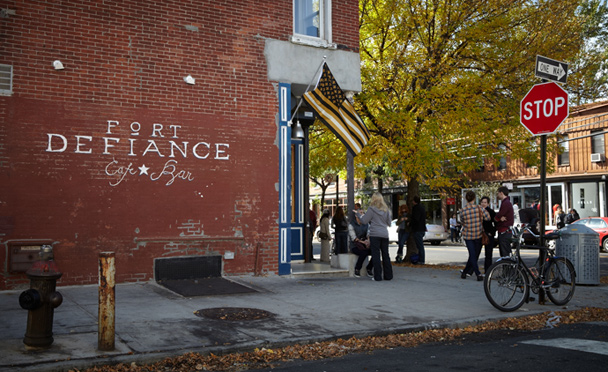If someone else had opened Fort Defiance, I wouldn’t have had to. All I wanted was a nice place within walking distance of my house that was open from early in the morning till late at night, where you could get a good cup of coffee, a decent Manhattan, and a bite to eat. In 2005, after four years of living in Red Hook, Brooklyn, I got tired of waiting.
At the time, I worked in the marketing department of a national food magazine. The day I realized I didn’t want my boss’ job, or anyone else’s at the company for that matter, I knew it was time to start thinking about what to do next. I toyed with a few ideas—freelance copyediting, maybe starting a boutique PR company—but when I let my mind really wander, it always returned to the days I spent working in cafés and restaurants during my eight years in New Orleans. The work was physically tough, the hours were long, and I always came home smelling like grease, Caesar salad, or sour milk. But I loved the life—especially the camaraderie among my coworkers and the countless opportunities to make people happy, in simple ways, throughout the day. And the people I worked for? Almost to a man, they were petty tyrants and buffoons, always chasing waitresses, giving bad advice, or getting in the way. The owner of a string of successful cafés in New Orleans once told me to leave the dishwasher door closed for a few minutes after a cycle, because “the steam helps dry the dishes.” If these guys ran restaurants, how hard could it be?
Around this time my father sent me The Great Good Place by sociologist Ray Oldenburg. In this book, first published in 1989, Oldenburg posits the concept of the “third place”—that space between home and work that serves as the center for “a vital informal public life” in all great societies—Japanese teahouses, Parisian cafés, German beer gardens. Oldenburg adds that the disappearance of the third place from the American landscape, coinciding with the rise of the “automobile suburb,” has all but erased the sense of social solidarity that many communities once enjoyed, and has put undue stress on the emotional health of American citizens. “Hope lies not with the expert or the official,” Oldenburg says, “but with those who use the environment built for them and find it wanting.” Not only was opening a café in Red Hook a good idea, it was my civic duty.
I quit the magazine and, after six months of traveling in South America and China, I re-entered the service industry. I spent three years getting my chops back up, working in restaurants and bars in New York, including 18 months at Pegu Club, perhaps one of the best cocktail bars in the world. Meanwhile, I looked for vacant storefronts, and learned to be patient, as dozens of deals fell through at the last minute. I remember walking, giddy with excitement, into the local VFW hall to sign a lease with Sue, a landlord born in Red Hook’s prewar glory days whom I had met earlier that week. I introduced myself, got out my checkbook, and asked to see the lease. “Who the hell are you?” she said. “I’ve never seen you before in my life.” After several more false starts, I signed a lease on the perfect corner spot, a block and a half away from my house, in the middle of Red Hook’s commercial strip. In the first week of 2009, the plywood went up, and we went to work.
The best waiter in the neighborhood, a straightlaced wine geek named Dhrubo, was between jobs, so I hired him to help me with the build-out, gutting the existing shoddy apartment and replacing it with a restaurant. He was completely unskilled in the manual arts, but I knew he would be vitally important later; I put him to work staining oak paneling and sourcing seltzer taps, promising it wouldn’t be long till he was waiting tables again. Friends and neighbors dropped by to help for an hour or two, a couple days, or a week. The two friends who helped me the most both own businesses in the neighborhood—Ben owns the Good Fork, a nearby restaurant, and Barry owns the Bait and Tackle, a bar up the street. I had worked for both of them over the previous three years, and that my new restaurant could be considered competition didn’t seem to occur to any of us. Their love of the neighborhood and their desire to see me succeed simply overwhelmed their self-interest.



 Pinterest
Pinterest


